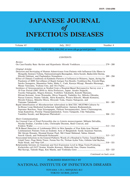Volume 65, Issue 4
Displaying 1-21 of 21 articles from this issue
- |<
- <
- 1
- >
- >|
Review
-
Article type: Review
2012 Volume 65 Issue 4 Pages 279-288
Published: 2012
Released on J-STAGE: September 21, 2012
Download PDF (1400K)
Original Article
-
Detection and Serotyping of Human Adenoviruses from Patients with Influenza-Like Illness in MongoliaArticle type: Original Article
2012 Volume 65 Issue 4 Pages 289-294
Published: 2012
Released on J-STAGE: September 21, 2012
Download PDF (952K) -
Article type: Original Article
2012 Volume 65 Issue 4 Pages 295-300
Published: 2012
Released on J-STAGE: September 21, 2012
Download PDF (560K) -
Article type: Original Article
2012 Volume 65 Issue 4 Pages 301-305
Published: 2012
Released on J-STAGE: September 21, 2012
Download PDF (206K) -
Article type: Original Article
2012 Volume 65 Issue 4 Pages 306-311
Published: 2012
Released on J-STAGE: September 21, 2012
Download PDF (1015K)
Short Communication
-
Article type: Short Communication
2012 Volume 65 Issue 4 Pages 312-314
Published: 2012
Released on J-STAGE: September 21, 2012
Download PDF (97K) -
Article type: Short Communication
2012 Volume 65 Issue 4 Pages 315-317
Published: 2012
Released on J-STAGE: September 21, 2012
Download PDF (734K) -
Article type: Short Communication
2012 Volume 65 Issue 4 Pages 318-321
Published: 2012
Released on J-STAGE: September 21, 2012
Download PDF (114K) -
Article type: Short Communication
2012 Volume 65 Issue 4 Pages 322-325
Published: 2012
Released on J-STAGE: September 21, 2012
Download PDF (710K) -
Article type: Short Communication
2012 Volume 65 Issue 4 Pages 326-329
Published: 2012
Released on J-STAGE: September 21, 2012
Download PDF (153K) -
Article type: Short Communication
2012 Volume 65 Issue 4 Pages 330-333
Published: 2012
Released on J-STAGE: September 21, 2012
Download PDF (443K) -
Article type: Short Communicaiton
2012 Volume 65 Issue 4 Pages 334-336
Published: 2012
Released on J-STAGE: September 21, 2012
Download PDF (1012K) -
Article type: Short Communication
2012 Volume 65 Issue 4 Pages 337-340
Published: 2012
Released on J-STAGE: September 21, 2012
Download PDF (321K) -
Article type: Short Communication
2012 Volume 65 Issue 4 Pages 341-344
Published: 2012
Released on J-STAGE: September 21, 2012
Download PDF (99K) -
Article type: Short Communication
2012 Volume 65 Issue 4 Pages 345-349
Published: 2012
Released on J-STAGE: September 21, 2012
Download PDF (298K)
Epidemiological Report
-
Article type: Epidemiological Report
2012 Volume 65 Issue 4 Pages 350-353
Published: 2012
Released on J-STAGE: September 21, 2012
Download PDF (119K)
Laboratory and Epidemiology Communications
-
Article type: Laboratory and Epidemiology Communications
2012 Volume 65 Issue 4 Pages 354-358
Published: 2012
Released on J-STAGE: September 21, 2012
Download PDF (863K) -
Occurrence of Toxigenic Vibrio cholerae in Accessible Water Sources of Cholera Endemic Foci in IndiaArticle type: Laboratory and Epidemiology Communications
2012 Volume 65 Issue 4 Pages 358-360
Published: 2012
Released on J-STAGE: September 21, 2012
Download PDF (92K) -
Article type: Laboratory and Epidemiology Communications
2012 Volume 65 Issue 4 Pages 360-362
Published: 2012
Released on J-STAGE: September 21, 2012
Download PDF (220K) -
Article type: Laboratory of Epidemiology and Communications
2012 Volume 65 Issue 4 Pages 363-367
Published: 2012
Released on J-STAGE: September 21, 2012
Download PDF (102K) -
Article type: Laboratory and Epidemiology Communications
2012 Volume 65 Issue 4 Pages 367-369
Published: 2012
Released on J-STAGE: September 21, 2012
Download PDF (2258K)
- |<
- <
- 1
- >
- >|
